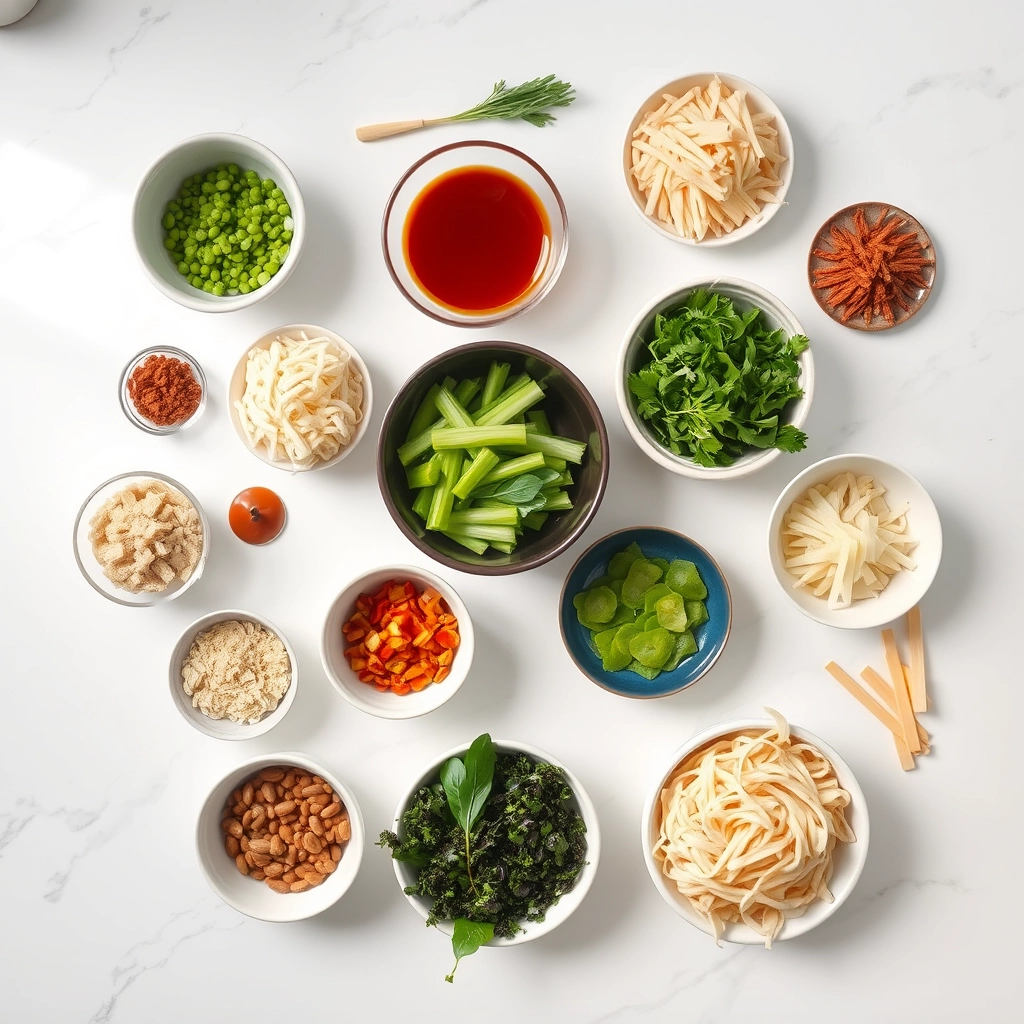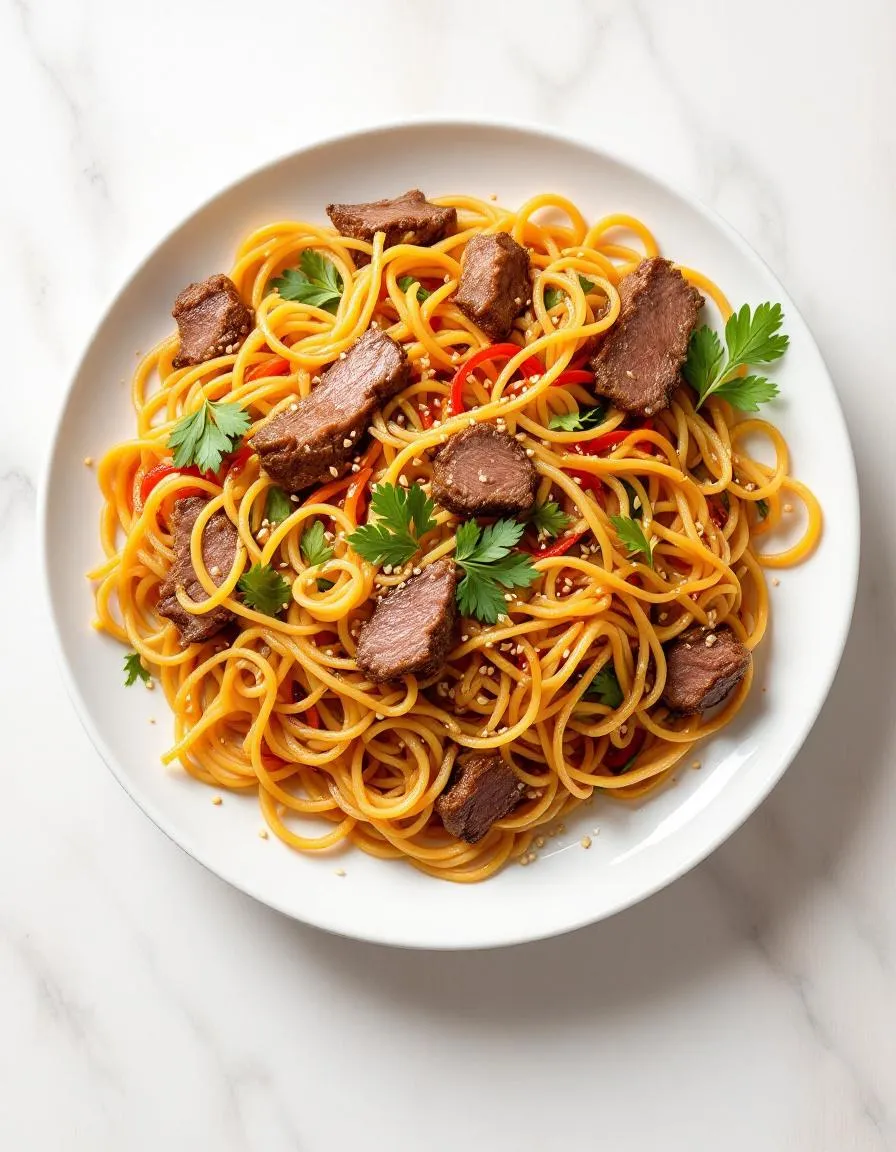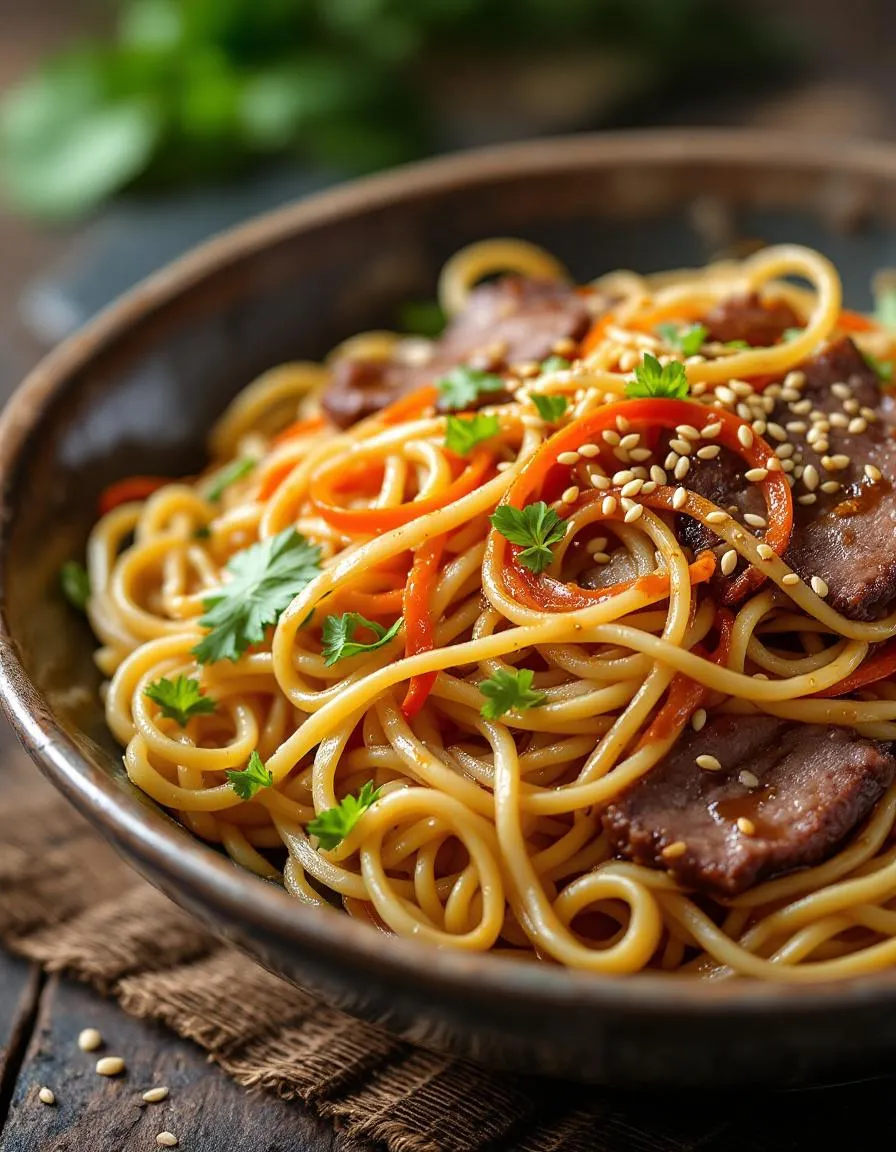Introduction
Hi there! I’m Emily, the heart and soul behind brekcakes.com. From my earliest memories, the kitchen has always been a place of warmth and creativity. It’s where I discovered the magic of turning simple ingredients into extraordinary meals and learned that the best dishes are often made with love as the main ingredient.
There’s something truly special about Korean Japchae Noodles that makes them more than just a dish—they’re a celebration of texture, flavor, and tradition. Whether you’re craving a comforting meal or want to impress guests with vibrant colors and bold tastes, this recipe delivers. Plus, it’s surprisingly easy to make at home, even if you’re new to Korean cuisine. Trust me, once you try these glossy, savory-sweet noodles tangled with crisp veggies, you’ll understand why they’ve stolen my heart (and probably yours too).
Korean Japchae Noodles, or simply japchae, is a beloved stir-fried dish featuring chewy sweet potato glass noodles, tender vegetables, and a glossy soy-sesame sauce. Unlike other noodle dishes, japchae stands out because it balances sweetness, umami, and a subtle nuttiness in every bite. Traditionally served at celebrations, it’s a dish that brings people together—much like the cozy gatherings I cherish. What I adore most is its versatility. You can customize it with your favorite proteins or keep it vegetarian, just like my go-to vegetarian dinner ideas. And while it might seem fancy, the steps are straightforward, making it perfect for weeknights or meal prep. If you’re exploring Korean flavors, japchae is a fantastic starting point—it’s approachable yet deeply satisfying, much like the comfort food recipes I grew up with.
Why I Love This Recipe
The first time I made Korean Japchae Noodles, I knew it would become a staple in my kitchen. It reminds me of the way food connects us—whether it’s sharing a plate with friends or savoring a quiet moment alone. The noodles have this irresistible bounce, and the sauce clings to every strand in the most delicious way. Every time I toss the vibrant veggies and watch them glisten, I feel like I’m creating something truly joyful. It’s more than a recipe to me; it’s a little reminder that good food doesn’t have to be complicated to feel special.
Health and Nutrition
Why it’s good for your body
Korean Japchae Noodles deliver a powerhouse of nutrients while satisfying your taste buds. First, the dish features sweet potato starch noodles, which offer a lower glycemic index than traditional wheat noodles. This means they provide steady energy without spiking blood sugar levels. Additionally, the colorful mix of vegetables like spinach, carrots, and bell peppers packs antioxidants that fight inflammation.
Moreover, Korean Japchae Noodles often include lean protein sources like beef or tofu. These ingredients help build and repair muscles while keeping you full longer. The sesame oil dressing adds healthy fats, which support heart health and brain function. Together, these components make the dish a balanced meal that nourishes your body from the inside out.
Finally, Korean Japchae Noodles are naturally gluten-free, making them a great option for those with sensitivities. The fiber-rich vegetables and noodles also promote digestion and gut health. Whether you’re looking for a nutrient-dense meal or a flavorful way to eat more veggies, this dish checks all the boxes.
How it fits in a healthy lifestyle
Korean Japchae Noodles easily fit into a balanced diet, whether you’re meal-prepping or enjoying a family dinner. The dish’s versatility allows you to customize it for specific goals, like boosting protein with extra tofu or keeping it light with more veggies. For gluten-free eaters, it’s a satisfying alternative to pasta-heavy meals.
If you’re focused on heart health, the minimal use of oil and emphasis on vegetables align perfectly with a low-cholesterol diet. Pair it with other nutrient-packed dishes like our kimchi fried rice for a well-rounded Korean-inspired feast. For those tracking macros, the noodles and protein combo offers a solid balance of carbs and protein to fuel your day.
Even on busy weeknights, Korean Japchae Noodles come together quickly, making healthy eating convenient. Explore our meal prep ideas to incorporate this dish into your routine without the stress. With its wholesome ingredients and adaptable nature, it’s a delicious way to stay on track with your wellness goals.
PrintKorean Japchae Noodles
Description
A delicious and colorful Korean stir-fried glass noodle dish with vegetables and beef.
Ingredients
For the Crust:
- 200g sweet potato starch noodles (dangmyeon)
- 100g beef (sirloin or ribeye), thinly sliced
- 1 carrot, julienned
- 1 red bell pepper, julienned
- 1 yellow bell pepper, julienned
- 1 cup spinach
- 4 shiitake mushrooms, sliced
- 3 cloves garlic, minced
- 3 tbsp soy sauce
- 2 tbsp sesame oil
- 1 tbsp sugar
- 1 tbsp toasted sesame seeds
- 1/2 tbsp vegetable oil
- Salt and pepper to taste
Instructions
1. Prepare the Crust:
- Soak the sweet potato noodles in warm water for 15 minutes, then boil for 5-7 minutes until tender. Drain and rinse with cold water. Toss with 1 tbsp sesame oil to prevent sticking.
- Marinate the beef with 1 tbsp soy sauce, 1/2 tbsp sugar, 1 minced garlic clove, and a pinch of black pepper for 10 minutes.
- In a large pan, heat vegetable oil over medium-high heat. Stir-fry the marinated beef until cooked through, then remove from pan.
- In the same pan, stir-fry each vegetable separately (carrots, bell peppers, spinach, mushrooms) with a pinch of salt. Remove each after cooking.
- Combine all cooked ingredients in the pan. Add noodles, remaining soy sauce, sugar, sesame oil, and minced garlic. Toss everything together over low heat for 2-3 minutes.
- Garnish with toasted sesame seeds and serve warm or at room temperature.
Notes
You can customize the seasonings to taste.

How to Prepare This Dish
Steps and time-saving tips
Start by soaking the Korean Japchae noodles in hot water for about 10 minutes until they soften. Meanwhile, slice your vegetables—bell peppers, carrots, and spinach—into thin strips for even cooking. Heat a large skillet over medium-high heat and drizzle in sesame oil. Toss in the vegetables and stir-fry them for 3-4 minutes until they’re crisp-tender. Remove them from the pan and set aside. Next, whisk together the sauce ingredients—soy sauce, brown sugar, minced garlic, and a splash of rice vinegar—in a small bowl. Drain the softened noodles and add them to the same skillet. Pour the sauce over the noodles and toss them gently to coat evenly. Let them cook for another 2 minutes, then fold in the stir-fried vegetables. For a protein boost, you can add thinly sliced beef or tofu, just like in my Korean BBQ Beef Bowl. Finish by sprinkling toasted sesame seeds and a drizzle of extra sesame oil for depth. Serve warm or chilled—Korean Japchae Noodles taste fantastic either way!
Mistakes I’ve made and learned from
When I first made Korean Japchae Noodles, I overcooked the noodles, leaving them mushy instead of springy. Now, I set a timer and taste-test them early to avoid this. Another blunder? Skipping the sesame oil—it’s essential for that nutty, authentic flavor. I also learned the hard way that overcrowding the pan makes the vegetables steam instead of fry. For perfectly crisp veggies, I cook them in batches, just like I do for my Stir-Fry Vegetable Medley. Lastly, don’t skip the final sesame seed garnish—it adds texture and ties everything together. Trust me, these small tweaks make all the difference!

Cultural Connection and Variations
Where this recipe comes from
Korean Japchae Noodles tell a story of celebration and tradition. Originally, this dish appeared in the 17th century as a royal court favorite, made with just vegetables and mushrooms. Over time, sweet potato starch noodles (dangmyeon) became the star, turning it into the vibrant, savory-sweet dish we love today. Families often serve Korean Japchae Noodles during holidays like Lunar New Year and Chuseok, symbolizing longevity and good fortune.
Across Korea, regional twists pop up. Some coastal towns add seafood, while others keep it vegetarian. In my family, we toss in extra spinach and a splash of sesame oil for depth. Meanwhile, Korean-American kitchens might swap in bell peppers or skip the meat for a vegan version. No matter the variation, the dish always balances textures—chewy noodles, crisp veggies, and that irresistible glossy finish.
How it fits in today’s cooking
Today, Korean Japchae Noodles bridge tradition and modern convenience. Meal preppers love it because it tastes even better the next day, and busy cooks appreciate its one-pan adaptability. You’ll spot it at potlucks alongside dishes like Korean BBQ beef bulgogi or as a standalone lunchbox star. Plus, gluten-free eaters cheer for dangmyeon noodles, which naturally skip wheat.
Home chefs also tweak it for speed—using pre-cut veggies or quick kimchi fried rice shortcuts. Yet even with shortcuts, the dish keeps its soul. Whether you’re honoring ancestors or just craving something hearty, Korean Japchae Noodles fit right in. They’re proof that some traditions only get better with time.
Taste and Texture
What makes it delicious
Korean Japchae Noodles deliver a symphony of flavors and textures that make every bite irresistible. The dish balances savory, sweet, and nutty notes, thanks to the rich soy-based sauce and caramelized vegetables. Glassy sweet potato noodles soak up the umami glaze, offering a satisfyingly chewy yet springy texture. Meanwhile, crisp bell peppers and earthy shiitake mushrooms add contrast, while toasted sesame seeds lend a fragrant crunch. Each forkful of Korean Japchae Noodles bursts with harmony, leaving a lingering warmth from the garlic and a subtle sweetness that keeps you reaching for more.
Boosting the flavor
Elevate your Korean Japchae Noodles with a few easy tweaks. For extra depth, swap regular soy sauce with Korean soup soy sauce, which adds a cleaner, more nuanced saltiness. Toss in spicy gochujang or a drizzle of homemade sesame oil for a toasty finish. Top with shredded nori or a fried egg for richness, or brighten the dish with a squeeze of lime. A sprinkle of chili flakes or fresh scallions also amps up the vibrancy without overpowering the delicate balance.

Tips for Success
Best practices for results
Always soak the sweet potato noodles for Korean Japchae Noodles in warm water first, as this ensures they cook evenly without turning mushy. Meanwhile, stir-fry the vegetables separately to retain their crisp texture before combining them with the noodles. For the best flavor, use toasted sesame oil and fresh garlic, and toss everything gently to avoid breaking the noodles. Finally, let the dish sit for a few minutes before serving so the flavors meld perfectly.
Mistakes to avoid
One common mistake is overcooking the noodles, which makes them sticky. Instead, check them a minute early and rinse under cold water to stop the cooking process. Another error is skipping the toasting step for the sesame seeds, which adds depth to Korean Japchae Noodles. For more tips on balancing flavors, check out our guide on Asian ingredient substitutions. Also, avoid overcrowding the pan when stir-frying, as this steams the vegetables. Learn proper techniques in our stir-fry secrets post.
Serving and Pairing Suggestions
How to serve this dish
Korean Japchae Noodles shine when served family-style on a large platter, letting the vibrant colors of the vegetables and glossy noodles take center stage. For a festive touch, garnish with toasted sesame seeds and thin strips of egg crepe. Alternatively, pack individual portions in bento boxes for a portable lunch or picnic. Since this dish works beautifully at room temperature, it’s perfect for potlucks or holiday gatherings. To elevate the presentation, pair it with traditional Korean side dishes like kimchi or pickled radish for a balanced spread.
What goes well with it
For a refreshing contrast, serve Korean Japchae Noodles with a crisp cucumber salad or a light miso soup. The cool crunch of cucumbers balances the savory-sweet noodles, while miso adds umami depth. If you’re hosting a Korean-inspired feast, try pairing it with our crispy Korean fried chicken for a satisfying combo of textures. To round out the meal, offer a fruity iced barley tea or a citrusy white wine, both of which cut through the dish’s richness. For dessert, our matcha tiramisu adds a delightful, slightly bitter finish that complements the noodles’ sweetness.

Korean Japchae Noodles are made from sweet potato starch noodles (dangmyeon), stir-fried with vegetables like spinach, carrots, and mushrooms, and often include beef or tofu. The dish is seasoned with soy sauce, sesame oil, and a touch of sugar for a balanced sweet-savory flavor. It’s a popular Korean dish served at celebrations and everyday meals.
Korean Japchae Noodles can be a healthy option when prepared with lean protein and plenty of vegetables. The sweet potato noodles are gluten-free and lower in calories than wheat noodles, while the dish provides fiber and nutrients from the veggies. Moderation is key, as the sauce can contain sugar and sodium.
Absolutely! Korean Japchae Noodles are easily adaptable for vegetarians by omitting meat and using tofu or extra mushrooms for protein. The dish still delivers its signature chewy texture and savory-sweet flavors from the noodles and sauce. Many traditional versions are naturally plant-based or can be adjusted with simple swaps.
Store leftover Korean Japchae Noodles in an airtight container in the refrigerator for up to 3 days. The noodles may harden when cold, so briefly reheat them in a pan with a splash of water or sesame oil to restore texture. Avoid freezing, as the vegetables and noodles can become mushy upon thawing.

